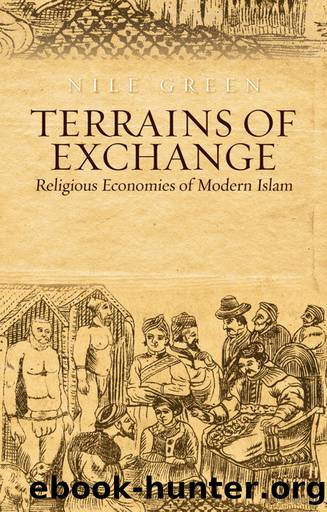Terrains of Exchange by Green Nile;

Author:Green, Nile; [Green, Nile;]
Language: eng
Format: epub
ISBN: 9780190222536
Publisher: OxfordUP
Published: 2014-09-15T00:00:00+00:00
EXPORTERS
PIOUS PASSENGERS, ISLAMIC MPRESARIOS
6
MAKING ISLAM IN THE MOTOR CITY
Highland Park is to be the center of Mohammadanism in the western worldâ¦
Detroit Free Press (1921)
Introduction
In the summer of 1921, a few minutes walk from Henry Fordâs factory in Highland Park, Michigan, there opened what was probably the first purpose-built mosque in the United States. Constructed at a cost of $55,000, it was funded by the Lebanese American real estate developer Muhammad Karroub, though its congregation drew from the multi-ethnic Muslim melting pot of the expanding motor city.1 Leading the prayers at the mosque was a recent immigrant from India named Mufti Muhammad Sadiq. Making full use of the cityâs media, he declared in the Detroit News that âthis is the first Moslem mosque built in this land and I am proud to have the first prayer in itâ.2 To Muhammad Sadiq, who had only disembarked in Philadelphia the previous year, the use of newspapers to claim leadership over Americaâs growing Muslim community was part of a deliberate strategy that defined his three-year stay in the United States. As his subsequent Urdu biography-cum-autobiography summarized his achievements, in America he âopened two mosques and converted around a thousand Christiansâ.3 For as the self-declared âfirst Muslim missionary to Americaâ, he imported to the religious marketplace of the urban Midwest the proselytizing techniques that in the previous half-century had been perfected in the âburned-over districtâ of Indiaâs Punjab.4 While Muhammad Sadiq has long been recognized as one of the foundational figures of American Islam, not least through winning the conversion of many of the first African American Muslims, what has not been recognized is the degree to which his success relied on the transfer to America of proselytizing techniques from the competitive religious economy of colonial India. It is this Indian input into American religious history that this chapter reveals.
Previous scholarship has tended to fix Muhammad Sadiq into his erstwhile American setting by linking him to narratives of the development of African American Islam that have their rightful place in the longer story of African American emancipation movements.5 Rather than emphasizing the American contexts of Muhammad Sadiqâs mission, by drawing on his Urdu âauto-hagiographyâ the following pages focus on its transnational dimensions by arguing that his activities and indeed success in the United States were the result of treating American society in exactly the same way that Indian Muslim missionaries treated the other environments in which they were operating worldwide by the 1920s.6 Rather than being part of a uniquely American story, the converts won by Muhammad Sadiq appear instead as players in a larger global process of Muslim expansion, particularly through the âAnglosphereâ, in which Indian religious firms were particularly effective.7 It is a process that reveals how Americaâs immigration history opened the American religious economy to entrepreneurs of distant Asian and Islamic provenance. Moreover, by drawing on a previously unused Urdu memoir of his life, we are able to see how America was perceived in Islamic terms: as part of an undifferentiated world of Muslim activity.
Download
This site does not store any files on its server. We only index and link to content provided by other sites. Please contact the content providers to delete copyright contents if any and email us, we'll remove relevant links or contents immediately.
| Civilization & Culture | Expeditions & Discoveries |
| Jewish | Maritime History & Piracy |
| Religious | Slavery & Emancipation |
| Women in History |
Cecilia; Or, Memoirs of an Heiress — Volume 1 by Fanny Burney(32064)
Cecilia; Or, Memoirs of an Heiress — Volume 3 by Fanny Burney(31459)
Cecilia; Or, Memoirs of an Heiress — Volume 2 by Fanny Burney(31409)
The Secret History by Donna Tartt(18169)
Sapiens: A Brief History of Humankind by Yuval Noah Harari(13993)
Leonardo da Vinci by Walter Isaacson(12807)
The Radium Girls by Kate Moore(11624)
Sapiens by Yuval Noah Harari(5125)
How Democracies Die by Steven Levitsky & Daniel Ziblatt(4965)
The Wind in My Hair by Masih Alinejad(4847)
Homo Deus: A Brief History of Tomorrow by Yuval Noah Harari(4691)
Endurance: Shackleton's Incredible Voyage by Alfred Lansing(4508)
Man's Search for Meaning by Viktor Frankl(4292)
The Silk Roads by Peter Frankopan(4275)
Millionaire: The Philanderer, Gambler, and Duelist Who Invented Modern Finance by Janet Gleeson(4105)
The Rape of Nanking by Iris Chang(4024)
Hitler in Los Angeles by Steven J. Ross(3801)
The Motorcycle Diaries by Ernesto Che Guevara(3788)
Joan of Arc by Mary Gordon(3786)
